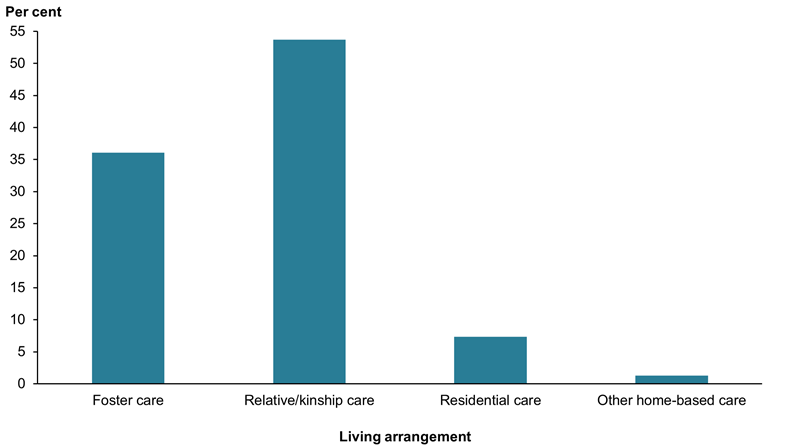What type of placements were children in?
Children living in home-based care (that is, in a family setting with a carer) have better developmental outcomes than those living in residential care with paid, rostered staff (AIFS et al. 2015; Cashmore 2011; DHHS 2014).
The vast majority of children in out-of-home care at 30 June 2021 (91% of around 46,200) were in home‑based care. Of those in out-of-home care:
- 54% were in relative/kinship care
- 36% were in foster care
- 1.3% were in other types of home-based care (Supplementary table S5.3).
Data on the relationship of relative/kinship carers were available for only 5 jurisdictions, representing 36% of children placed with relative/kinship carers at 30 June 2021. For jurisdictions with available data, the most common placement was with grandparents (20%), followed by an aunt/uncle (9.0%). Only 3.1% of children in relative/kinship care were placed in a non-familial relationship (Supplementary table S5.4).
Nationally, 7.3% of children in out‑of‑home care were living in residential care (Figure 5.3). Residential care is used mainly for children who have complex needs. However, in many jurisdictions priority is given to keeping siblings together, which sometimes results in periods of residential care for larger family groups.
Figure 5.3: Children in out-of-home care, by type of placement, 30 June 2021 (per cent)

Note: Variation across jurisdictions in policy/practice for recording living arrangement types affects these results (see Supplementary table S5.3 for more information).
Chart: AIHW.
Source: Supplementary data table S5.3, AIHW Child Protection Collection 2020–21.
Table 5.2 provides further information on the types of placements considered to be in‑scope for out-of-home care.
| Type of out-of-home care | Where is the child living? | Who is caring for the child? |
|---|---|---|
| Home-based care | The home of a carer who is reimbursed for care expenses. This includes relative/kinship care, foster care and other home-based out-of-home care. | A nominated and approved carer such as a relative, family friend or non-familial foster carer. |
| Residential care | In a residential building with paid staff. | Staff employed to provide care to children placed in the residence. |
| Family group homes | A home provided by a department or agency. | Live-in carers who are reimbused and/or subsidised for providing care to the child. |
| Independent living | A private board or lead tenant household. | The child is responsible for their own care, with the department retaining oversight of their welfare. |
| Other | The child may have another living arrangement, such as in a disability service, boarding school, hospital or hotel/motel. | These placements may have rostered or paid staff but are generally not home-like environments. |
References
For a full list of references, go to References.


